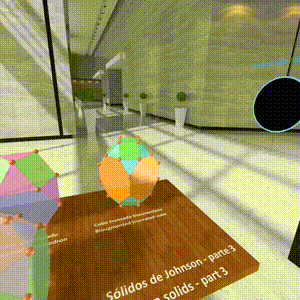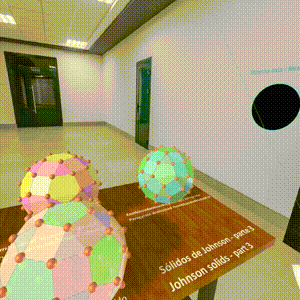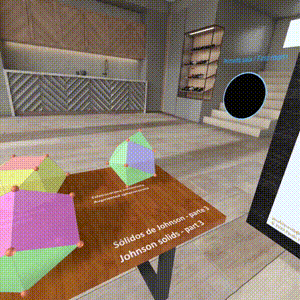Visualization of polyhedra with Augmented Reality (AR) and Virtual Reality (VR) in A-frame
author: Paulo Henrique Siqueira - Universidade Federal do Paraná
contact: paulohscwb@gmail.com
versão em português
 Johnson solids - part 3: J63 - J92
Johnson solids - part 3: J63 - J92
A Johnson solid is a strictly convex regular-faced polyhedron that is not uniform. They are named after Norman Woodason Johnson, who in 1966 first listed all 92 such polyhedra. In third part, we have more 30 Johnson solids.
Augmented Reality | 3D Models | Home
Immersive rooms
🔗 room 1 | 🔗 room 2 | 🔗 room 3



Augmented Reality
To view Johnson solids in AR, simply visit:
https://paulohscwb.github.io/polyhedra/johnson3/ra.html
with any browser with a webcam device (smartphone, tablet or notebook).
Access to the VR sites is done by clicking on the blue circle that appears on top of the marker.


3D models
1. Tridiminished icosahedron


J63 The tridiminished icosahedron, or teddi, is one of the 92 Johnson solids. It can be constructed by removing 3 mutually non-adjacent vertices from a regular icosahedron. The name refers to one way of constructing it, by removing three pentagonal pyramids J2 from a regular icosahedron, which replaces three sets of five triangular faces from the icosahedron with three mutually adjacent pentagonal faces.
Faces: 5 triangles and 3 pentagons | Edges: 15 | Vertices: 9 | Dihedral angles: 138.19°, 100.81° and 63.43°. More…
2. Augmented tridiminished icosahedron


J64 The augmented tridiminished icosahedron, or auteddi, is one of the Johnson solids. It can be constructed by attaching a tetrahedron, seen as a triangular pyramid, to the triangular face of the tridiminished icosahedron that is connected only to pentagons. It is the only Johnson solid that is constructed using both diminishing and augmenting, assuming that no diminishing and augmenting cancel each other out.
Faces: 7 triangles and 3 pentagons | Edges: 18 | Vertices: 10 | Dihedral angles: 171.34°, 138.19°, 100.81°, 70.53° and 63.43°. More…
3. Augmented truncated tetrahedron


J65 The augmented truncated tetrahedron, or autut, is one of the Johnson solids. It can be constructed by attaching a triangular cupola J3 to one of the hexagonal faces of the truncated tetrahedron.
Faces: 8 triangles, 3 squares and 3 hexagons | Edges: 27 | Vertices: 15 | Dihedral angles: 164.21°, 141.06°, 125.26°, 109.47° and 70.53°. More…
4. Augmented truncated cube


J66 The augmented truncated cube, or autic, is one of the Johnson solids. It can be constructed by attaching a square cupola J4 to one of the octagonal faces of the truncated cube.
Faces: 12 triangles, 5 squares and 5 octagons | Edges: 48 | Vertices: 28 | Dihedral angles: 170.26°, 144.74°, 135°, 125.26° and 90°. More…
5. Biaugmented truncated cube


J67 The biaugmented truncated cube, or bautic, is one of the Johnson solids. It can be constructed by attaching square cupolas J4 to two opposite octagonal faces of the truncated cube.
Faces: 16 triangles, 10 squares and 4 octagons | Edges: 60 | Vertices: 32 | Dihedral angles: 170.26°, 144.74°, 135°, 125.26° and 90°. More…
6. Augmented truncated dodecahedron


J68 The augmented truncated dodecahedron, or autid, is one of the Johnson solids. It can be constructed by attaching a pentagonal cupola J5 to one of the decagonal faces of the truncated dodecahedron.
Faces: 25 triangles, 5 squares, 1 pentagon and 11 decagons | Edges: 105 | Vertices: 65 | Dihedral angles: 174.34°, 159.09°, 153.94°, 148.28°, 142.62° and 116.57°. More…
7. Parabiaugmented truncated dodecahedron


J69 The parabiaugmented truncated dodecahedron, or pabautid, is one of the Johnson solids. It can be constructed by attaching two pentagonal cupolas J5 to two opposite decagonal faces of the truncated dodecahedron.
Faces: 30 triangles, 10 squares, 2 pentagons and 10 decagons | Edges: 120 | Vertices: 70 | Dihedral angles: 174.34°, 159.09°, 153.94°, 148.28°, 142.62° and 116.57°. More…
8. Metabiaugmented truncated dodecahedron


J70 The metabiaugmented truncated dodecahedron, or mabautid, is one of the Johnson solids. It can be constructed by attaching two pentagonal cupolas J5 to two non-opposite, non-adjacent decagonal faces of the truncated dodecahedron.
Faces: 30 triangles, 10 squares, 2 pentagons and 10 decagons | Edges: 120 | Vertices: 70 | Dihedral angles: 174.34°, 159.09°, 153.94°, 148.28°, 142.62° and 116.57°. More…
9. Triaugmented truncated dodecahedron


J71 The triaugmented truncated dodecahedron, or tautid, is one of the Johnson solids. It can be constructed by attaching pentagonal cupolas J5 to three mutually non-adjacent decagonal faces of the truncated dodecahedron.
Faces: 35 triangles, 10 squares, 3 pentagons and 9 decagons | Edges: 135 | Vertices: 75 | Dihedral angles: 174.34°, 159.09°, 153.94°, 148.28°, 142.62° and 116.57°. More…
10. Gyrate rhombicosidodecahedron


J72 The gyrate rhombicosidodecahedron, or gyrid, is one of the Johnson solids. It can be constructed by rotating one of the pentagonal cupolaic caps of the small rhombicosidodecahedron by 36°.
Faces: 20 triangles, 30 squares and 12 pentagons | Edges: 120 | Vertices: 60 | Dihedral angles: 159.09°, 153.94°, 153.43° and 148.28°. More…
11. Parabigyrate rhombicosidodecahedron


J73 The parabigyrate rhombicosidodecahedron, or pabgyrid, is one of the Johnson solids. It can be constructed by rotating two opposite pentagonal cupolaic caps of the small rhombicosidodecahedron by 36°.
Faces: 20 triangles, 30 squares and 12 pentagons | Edges: 120 | Vertices: 60 | Dihedral angles: 159.09°, 153.94°, 153.43° and 148.28°. More…
12. Metabigyrate rhombicosidodecahedron


J74 The metabigyrate rhombicosidodecahedron, or mabgyrid, is one of the Johnson solids. It can be constructed by rotating two non-opposite pentagonal cupolaic caps of the small rhombicosidodecahedron by 36°.
Faces: 20 triangles, 30 squares and 12 pentagons | Edges: 120 | Vertices: 60 | Dihedral angles: 159.09°, 153.94°, 153.43° and 148.28°. More…
13. Trigyrate rhombicosidodecahedron


J75 The trigyrate rhombicosidodecahedron, or tagyrid, is one of the Johnson solids. It can be constructed by rotating three mutually non-adjacent pentagonal cupolaic caps of the small rhombicosidodecahedron by 36°.
Faces: 20 triangles, 30 squares and 12 pentagons | Edges: 120 | Vertices: 60 | Dihedral angles: 159.09°, 153.94°, 153.43° and 148.28°. More…
14. Diminished rhombicosidodecahedron


J76 The diminished rhombicosidodecahedron, or dirid, is one of the Johnson solids. It can be constructed by removing one of the pentagonal cupolaic caps of the small rhombicosidodecahedron.
Faces: 15 triangles, 25 squares, 11 pentagons and 1 decagon | Edges: 105 | Vertices: 55 | Dihedral angles: 159.09°, 121.72°, 116.57° and 148.28°. More…
15. Paragyrate diminished rhombicosidodecahedron


J77 The paragyrate diminished rhombicosidodecahedron, or pagydrid, is one of the Johnson solids. It can be constructed by removing one of the pentagonal cupolaic caps of the small rhombicosidodecahedron, and rotating the opposite cap by 36°.
Faces: 15 triangles, 25 squares, 11 pentagons and 1 decagon | Edges: 105 | Vertices: 55 | Dihedral angles: 159.09°, 121.72°, 153.43°, 153.94°, 116.57° and 148.28°. More…
16. Metagyrate diminished rhombicosidodecahedron


J78 The metagyrate diminished rhombicosidodecahedron, or magydrid, is one of the Johnson solids. It can be constructed by removing one of the pentagonal cupolaic caps of the small rhombicosidodecahedron, and rotating another non-opposite cap by 36°.
Faces: 15 triangles, 25 squares, 11 pentagons and 1 decagon | Edges: 105 | Vertices: 55 | Dihedral angles: 159.09°, 121.72°, 153.43°, 153.94°, 116.57° and 148.28°. More…
17. Bigyrate diminished rhombicosidodecahedron


J79 The bigyrate diminished rhombicosidodecahedron, or bagydrid, is one of the Johnson solids. It can be constructed by removing one of the pentagonal cupolaic caps of the small rhombicosidodecahedron, and rotating two further non-opposite caps by 36°.
Faces: 15 triangles, 25 squares, 11 pentagons and 1 decagon | Edges: 105 | Vertices: 55 | Dihedral angles: 159.09°, 121.72°, 153.43°, 153.94°, 116.57° and 148.28°. More…
18. Parabidiminished rhombicosidodecahedron


J80 The parabidiminished rhombicosidodecahedron, or pabidrid, is one of the Johnson solids. It can be constructed by removing two opposite pentagonal cupolaic caps of the small rhombicosidodecahedron.
Faces: 10 triangles, 20 squares, 10 pentagons and 2 decagons | Edges: 90 | Vertices: 50 | Dihedral angles: 159.09°, 121.72°, 116.57° and 148.28°. More…
19. Metabidiminished rhombicosidodecahedron


J81 The metabidiminished rhombicosidodecahedron, or mabidrid, is one of the Johnson solids. It can be constructed by removing two non-opposite pentagonal cupolaic caps of the small rhombicosidodecahedron.
Faces: 10 triangles, 20 squares, 10 pentagons and 2 decagons | Edges: 90 | Vertices: 50 | Dihedral angles: 159.09°, 121.72°, 116.57° and 148.28°. More…
20. Gyrate bidiminished rhombicosidodecahedron


J82 The gyrate bidiminished rhombicosidodecahedron, or gybadrid, is one of the Johnson solids. It can be constructed by removing two non-opposite pentagonal cupolaic caps of the small rhombicosidodecahedron, and rotating a third cap by 36°.
Faces: 10 triangles, 20 squares, 10 pentagons and 2 decagons | Edges: 90 | Vertices: 50 | Dihedral angles: 159.09°, 121.72°, 153.43°, 153.94°, 116.57° and 148.28°. More…
21. Tridiminished rhombicosidodecahedron


J83 The tridiminished rhombicosidodecahedron, or tedrid, is one of the Johnson solids. It can be constructed by removing three pentagonal cupolaic caps of the small rhombicosidodecahedron.
Faces: 5 triangles, 15 squares, 9 pentagons and 3 decagons | Edges: 75 | Vertices: 45 | Dihedral angles: 159.09°, 121.72°, 116.57° and 148.28°. More…
22. Snub disphenoid


J84 The snub disphenoid, or snadow, is one of the Johnson solids. It can be constructed from a tetrahedron, seen as a digonal antiprism or disphenoid, by expanding the halves outward and inserting a set of 8 triangles in between the halves.
Faces: 12 triangles | Edges: 18 | Vertices: 8 | Dihedral angles: 96.2°, 121.74° and 166.44°. More…
23. Snub square antiprism


J85 The snub square antiprism, or snisquap, is one of the Johnson solids. It can be constructed from a square antiprism by expanding the halves outward and inserting a set of 16 triangles in between the halves.
Faces: 24 triangles and 2 squares | Edges: 40 | Vertices: 16 | Dihedral angles: 144.14°, 119.11°, 164.26°, 145.44° and 114.65°. More…
24. Sphenocorona


J86 The sphenocorona, or waco, is one of the Johnson solids. It is one of several polyhedra near the end of the list of Johnson solids with no obvious relation to any of the uniform polyhedra. The name is derived from “spheno” (meaning a wedge-like arrangement of two “lunes”, where each lune consists of a square attached to two triangles) and “corona” denoting a crown-like structure composed of 8 triangles.
Faces: 12 triangles and 2 squares | Edges: 22 | Vertices: 10 | Dihedral angles: 143.48°, 135.99°, 159.89°, 118.89°, 131.44°, 97.46°, 109.52° and 117.02°. More…
25. Augmented sphenocorona


J87 The augmented sphenocorona, or auwaco, is one of the Johnson solids. It can be constructed by attaching a square pyramid to one of the square faces of the sphenocorona J86.
Faces: 16 triangles and 1 square | Edges: 26 | Vertices: 11 | Dihedral angles: 143.48°, 135.99°, 114.74°, 159.89°, 118.89°, 131.44°, 97.46°, 109.52°, 164.26°, 171.75° and 152.19°. More…
26. Sphenomegacorona


J88 The sphenomegacorona, or wamco, is one of the Johnson solids. The name is derived from “spheno”, meaning a wedge-like arrangement of two “lunes”, where each lune consists of a square attached to two triangles, and “megacorona”, denoting a large crown-like structure composed of 12 triangles, as opposed to the smaller “corona” of 8 triangles found in the sphenocorona.
Faces: 16 triangles and 2 squares | Edges: 28 | Vertices: 12 | Dihedral angles: 86.72°, 117.36°, 129.44°, 137.24°, 143.74°, 154.72°, 161.48° and 171.65°. More…
27. Hebesphenomegacorona


J89 The hebesphenomegacorona, or hawmco, is one of the Johnson solids. The name is derived from “hebespheno” (meaning a wedge-like arrangement of three “lunes”, where each lune consists of a square attached to two triangles) and “megacorona” denoting a crown-like structure composed of 12 triangles (as opposed to the smaller “corona” of 8 triangles found in the sphenocorona). It has a weak relation to the icosahedron: if the middle square is contracted to an edge such that the neighboring squares become triangles and the neighboring triangles touch, the result is an icosahedron.
Faces: 18 triangles and 3 squares | Edges: 33 | Vertices: 14 | Dihedral angles: 157.15°, 141.34°, 128.5°, 111.73°, 149.56°, 101.29°, 152.98°, 102.52° and 133.97°. More…
28. Disphenocingulum


J90 The disphenocingulum, or dawci, is one of the Johnson solids. The name is derived from “spheno” (meaning a wedge-like arrangement of two “lunes”, where each lune consists of a square attached to two triangles - “di” signifying two such complexes) and “cingulum” denoting a crown-like belt of 12 triangles.
Faces: 20 triangles and 4 squares | Edges: 38 | Vertices: 16 | Dihedral angles: 124.7°, 148.43°, 133.59°, 166.81°, 154.42°, 134.34° and 100.19°. More…
29. Bilunabirotunda


J91 The bilunabirotunda, or bilbiro, is one of the Johnson solids. The “birotunda” in the name signifies two rotundas, while the “biluna” refers to the two lunes (sections with a square connecting to two triangles). If the “rotunda” parts of two bilunabirotundae are aligned with opposite corresponding parts of an icosidodecahedron, they touch at the center of the icosidodecahedron because each bilunabirotunda’s height in this direction is exactly half that of the icosidodecahedron height.
Faces: 8 triangles, 2 squares and 4 pentagons | Edges: 26 | Vertices: 14 | Dihedral angles: 159.09°, 142.62°, 110.95°, 100.81° and 63.43°. More…
30. Triangular hebesphenorotunda


J92 The triangular hebesphenorotunda, or thawro, is one of the Johnson solids. The triangular hebesphenorotunda has a minor connection with the small rhombicosidodecahedron. The triangles and squares forming the “lune” portion of the shape are congruent with corresponding triangles and squares of the small rhombicosidodecahedron.
Faces: 13 triangles, 3 squares, 3 pentagons and 1 hexagon | Edges: 36 | Vertices: 18 | Dihedral angles: 159.09°, 142.62°, 138.19°, 110.95° and 100.81°. More…

Johnson solids part 3 (J63 - J92): Visualization of polyhedra with Augmented Reality and Virtual Reality by Paulo Henrique Siqueira is licensed with a license Creative Commons Attribution-NonCommercial-NoDerivatives 4.0 International.
How to cite this work:
Siqueira, P.H., "Johnson solids part 3 (J63 - J92): Visualization of polyhedra with Augmented Reality and Virtual Reality". Available in: <https://paulohscwb.github.io/polyhedra/johnson3/>, July 2023.
References:
Weisstein, Eric W. “Johnson Solid” From MathWorld-A Wolfram Web Resource. https://mathworld.wolfram.com/JohnsonSolid.html
Polytope Miraheze https://polytope.miraheze.org/wiki/Johnson_solid
Wikipedia https://en.wikipedia.org/wiki/Johnson_solid
McCooey, David I. “Visual Polyhedra”. http://dmccooey.com/polyhedra/